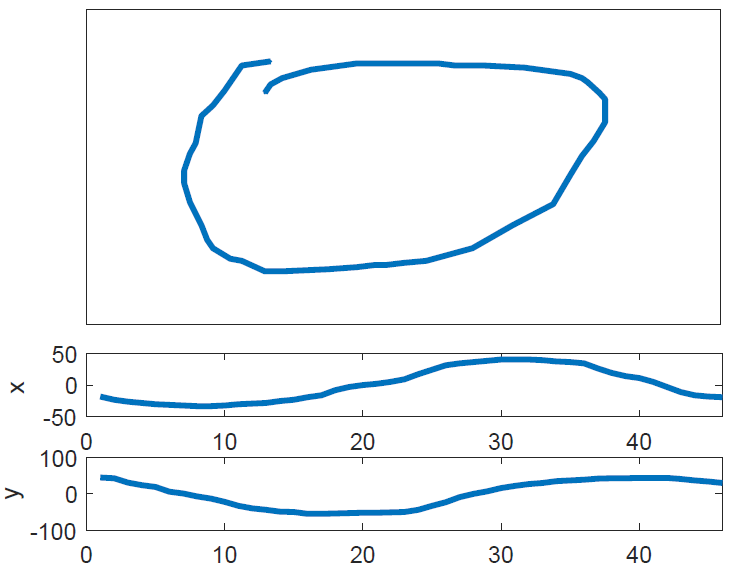|
INSTRUCTIONS FOR DOWNLOADING
e-BioDigitDB
-
Download license agreement,
send by email one signed and scanned copy to atvs@uam.es according to the instructions given in point 2.
-
Send an email to atvs@uam.es, as follows:
Subject:
[DATABASE download: e-BioDigitDB]
Body: Your name, e-mail, telephone
number, organization, postal mail, purpose for which you will use
the database, time and date at which you sent the email with the
signed license agreement.
-
Once the email copy of the license
agreement has been received at ATVS, you will receive an email with a
username, a password, and a time slot to download the database.
-
Download the database, for which you will need to provide the
authentication information given in step 4. After you finish the
download, please notify by email to atvs@uam.es that you have
successfully completed the transaction.
-
For more information, please contact: atvs@uam.es
DESCRIPTION OF e-BioDigitDB
The e-BioDigit database comprises on-line handwritten numerical digits from 0 to 9 acquired
using a Samsung Galaxy Note 10.1 general purpose tablet for a total of 93 users. All samples were acquired using the finger touch as input so only information related to X
and Y spatial coordinates are considered.
Regarding the acquisition protocol, data subjects had to perform handwritten numerical digits from 0 to 9 one at a time. Some examples of the handwritten numerical digits
acquired for the e-BioDigit database are depicted in Figure 1. Additionally, samples were collected in two sessions with a time gap of at least three weeks between them
in order to consider inter-session variability, very important for behavioural biometric traits. For each session, users had to perform a total of 4 numerical sequences
from 0 to 9. Therefore, there are a total of 8 samples per numerical digit and user.
The software for capturing handwritten numerical digits was developed in order to minimize the variability of the user during the acquisition process. A rectangular area with
a writing surface size similar to a 5-inch screen smartphone was considered . A horizontal line was represented in the bottom part of the rectangular area, including two buttons
OK and Cancel to press after writing if the sample was good or bad respectively. If the sample was not good, then it was repeated.



Figure 1. Examples of different handwritten numerical digits of the e-BioDigit database. X and Y denote horizontal and vertical position
versus the time samples. [CVPR2018_OTP].
The handwritten numerical digits are stored in text files, where:
The nomenclature followed to name the numerical digit files is as follows: uAAA_digit_B_CCC.txt
AAA: indicates the number of the user [101, 102, ... , 208]. Some users in between were finally removed having in total 93 users. B: indicates the numerical digit [0, 1, ... , 9]. CCC: indicates the number of the acquisition sample [002, 004, ... , 016]. There are a total of 8 samples per numerical digit and user.
Finally, handwritten numerical digits are organized into "session_1" and "session_2" folders.
REFERENCES
For further information on the database and on different applications where it has been used, we refer the reader to (all these articles are publicly
available in the publications section of the BiDA group webpage.)
-
[TMC2019_OTP] R. Tolosana, R. Vera-Rodriguez, and J. Fierrez, "BioTouchPass: Handwritten Passwords
for Touchscreen Biometrics", IEEE Transactions on Mobile Computing, 2019.
-
[CVPR2018_OTP] R. Tolosana, R. Vera-Rodriguez, J. Fierrez and J. Ortega-Garcia,
"Incorporating Touch Biometrics to Mobile One-Time Passwords: Exploration of Digits.",
in Proc. IEEE Conf. on Computer Vision and Pattern Recognition Workshops, CVPRW, Salt Lake City, USA, 2018..
Please remember to reference articles [TMC2019_OTP, CVPR2018_OTP] on any work made public, whatever the form, based directly or indirectly on any part of the e-BioDigitDB database.
ACKNOWLEDGMENTS
-
The acquisition of this database has been supported by projects: COGNIMETRICS (TEC2015-70627-R MINECO/FEDER), BIBECA (RTI2018- 101248-B-I00 MINECO/FEDER), Bio-Guard (Ayudas Fundación BBVA a Equipos de Investigación Científica 2017) and Cecabank. The work of R. Tolosana was supported by a FPU Fellowship from Spanish MECD.
|


